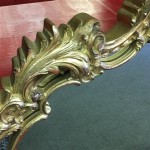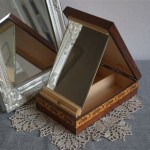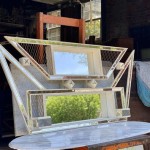How To Hang A Huge, Heavy Mirror
Hanging a large, heavy mirror presents a unique set of challenges compared to hanging a smaller, lighter one. Improper installation can lead to the mirror falling, causing damage to the mirror itself, the wall, and potentially injuring someone. Therefore, meticulous planning and the use of appropriate hardware are paramount for a successful and safe installation. This article provides a comprehensive guide on how to hang a huge, heavy mirror, covering essential considerations from preparation to execution.
Before initiating the hanging process, it is crucial to assess the mirror's dimensions and weight. Knowing the exact weight allows for the selection of adequate mounting hardware. Most mirrors will have the weight listed on the packaging or the back of the mirror itself. If the weight is not readily available, a bathroom scale can be used. Carefully place the mirror on the scale, noting the reading. It is better to overestimate than underestimate the weight when selecting hardware to provide an added margin of safety.
Next, determine the wall composition. Walls are typically constructed of drywall, plaster, or masonry. Each material requires specific anchors and installation techniques. Drywall is the most common wall type in modern homes but offers the least structural support. Understanding the wall type is vital for selecting the correct anchors and mounting system.
Key Point 1: Selecting the Right Hardware
The selection of appropriate hardware is the most critical aspect of hanging a heavy mirror. The hardware must be capable of supporting the mirror's weight and distributing it evenly across the wall. Failure to choose the right hardware can result in the mirror detaching from the wall, leading to potential damage and injury. Three primary types of hardware are commonly used for hanging heavy mirrors: heavy-duty picture hanging hooks, mounting bars, and French cleats.
Heavy-duty picture hanging hooks are suitable for mirrors weighing up to a certain limit, typically specified by the manufacturer. These hooks are designed to be hammered into the wall, securing themselves in place. When using these hooks, it is essential to select hooks rated for significantly more weight than the mirror's actual weight. For instance, if a mirror weighs 50 pounds, hooks rated for at least 75 pounds are recommended to provide a safety margin. It is also important to ensure that the hooks are hammered into a stud or that drywall anchors are used in conjunction with the hook if a stud is not available. Drywall anchors will help to distribute the weight over a larger area of the drywall.
Mounting bars are metal bars that are attached to the wall and the back of the mirror. The mirror is then hung on the bars, distributing the weight evenly. Mounting bars are often used for mirrors without pre-existing hanging hardware. The bars are typically screwed into the wall studs for maximum support. When using mounting bars, it is crucial to ensure that the bars are properly aligned and securely attached to both the wall and the mirror. The hardware that comes with the mounting bar should be appropriate for the weight of the mirror, and should be confirmed before mounting.
French cleats consist of two interlocking pieces of wood or metal. One piece is attached to the wall, and the other is attached to the back of the mirror. The angled design allows the mirror to securely hang on the wall, distributing the weight along the entire length of the cleat. French cleats are particularly effective for hanging heavy mirrors because they provide a strong and stable mounting solution. When installing a French cleat, it is essential to ensure that both pieces are level and securely attached to the wall studs or using appropriate drywall anchors.
Beyond the primary hanging hardware, consider using wire or D-rings if there is no existing hardware on the mirror. Wire should be thick gauge and rated for more than the mirror's weight. The D-rings should be securely attached to the back of the mirror frame with screws that are appropriate for the material of the frame and that are not so long that they penetrate the front of the mirror frame. When attaching the wire, ensure that it is taut and securely fastened to the D-rings. It is often advisable to use two or more D-rings to distribute the weight more evenly and reduce the risk of the wire breaking.
Key Point 2: Locating Wall Studs and Using Anchors
Finding wall studs is an integral step in safely securing a heavy mirror. Wall studs are vertical wooden or metal beams that provide structural support for the wall. Screwing directly into a stud provides the most secure and stable anchor point. Studs are typically spaced 16 or 24 inches apart. A stud finder is the most reliable tool for locating studs. These devices use electronic sensors to detect changes in density behind the wall, indicating the presence of a stud.
To use a stud finder, follow the manufacturer's instructions. Typically, the stud finder is calibrated by placing it flat against the wall and pressing a button. Once calibrated, slowly move the stud finder horizontally across the wall. When the stud finder detects a stud, it will usually emit a sound or light up. Mark the location of the stud with a pencil. It is advisable to verify the stud location by driving a small nail into the wall at the marked spot. If the nail hits solid wood, a stud has been located. If the nail easily penetrates the wall and feels hollow, then a stud has not been located.
If a stud cannot be located in the desired hanging location, drywall anchors must be used. Drywall anchors are designed to provide a secure anchor point in drywall where there is no underlying stud. There are various types of drywall anchors available, each with different weight capacities and installation methods. Toggle bolts are a popular option for heavy mirrors. These anchors consist of a bolt and a wing-like toggle that expands behind the drywall, providing a strong and secure hold.
To install toggle bolts, drill a hole in the drywall that is large enough to accommodate the toggle. Fold the toggle wings and insert the toggle and bolt through the hole. Once the toggle is behind the drywall, the wings will spring open, creating a secure anchor. Tighten the bolt to secure the mirror to the wall. It is important to select toggle bolts that are rated for the weight of the mirror and to follow the manufacturer's instructions carefully. Other types of drywall anchors, such as self-drilling anchors and wall anchors, can also be used, but toggle bolts generally provide the most robust support for heavy mirrors.
Key Point 3: Step-by-Step Installation Process
Once the hardware has been selected and the wall studs or anchor points have been located, the actual installation process can begin. This step requires precision and careful execution to ensure that the mirror is hung securely and level. The first step is to measure and mark the desired hanging location on the wall.
After the hanging location has been marked, pre-drill holes for the screws or anchors. If screwing into a stud, pre-drilling a pilot hole will make it easier to drive the screw and prevent the wood from splitting. If using drywall anchors, drill the holes according to the manufacturer's instructions. Ensure that the holes are the correct size and depth for the screws or anchors being used.
Attach the hanging hardware to the wall. If using heavy-duty picture hanging hooks, hammer the hooks into the wall at the marked location. If using mounting bars or French cleats, screw the hardware into the studs or drywall anchors. Ensure that the hardware is level and securely attached to the wall. For French cleats, make sure that both the wall and mirror pieces are aligned correctly to ensure a secure fit.
With the wall-mounted hardware in place, carefully lift the mirror and hang it on the hardware. If using wire and D-rings, ensure that the wire is securely placed over the hooks or mounting bars. If using mounting bars or French cleats, align the mirror with the hardware and gently slide it into place. Once the mirror is hanging, double-check that it is level using a level. If necessary, make minor adjustments to the hardware to ensure that the mirror is perfectly level. A helper can be useful in this step as well.
Finally, test the stability of the mirror by gently pushing on it to ensure that it is securely attached to the wall. If the mirror feels loose or wobbly, re-tighten the screws or anchors or consider adding additional hardware for added support. For extremely heavy mirrors, it may be necessary to use multiple mounting points to distribute the weight more evenly. Regularly check the mirror's stability over time and make any necessary adjustments to ensure that it remains securely hung.
By following these steps and using appropriate hardware, a large, heavy mirror can be hung safely and securely. Taking the time to plan and execute the installation process carefully will ensure that the mirror remains in place and that the wall and its surroundings are protected from damage.

How To Hang A Large Or Heavy Mirror

How To Hang A Heavy Mirror With Pictures Wikihow

How To Hang A Heavy Mirror C R F T Hanging Diy Home Improvement

How To Hang A Mirror With Wire Pictures Wikihow

Calling It Home How To Hang Something Heavy Like A Pro Diy Improvement Projects Hanging Mirror

How To Hang A 31kg Mirror On Wall With Bunnings Work Community

How To Hang A Heavy Mirror Daisymaebelle Home Diy Decor

How To Hang A Heavy Mirror

How To Hang A Heavy Mirror Lowe S

How I Installed A Really Big Mirror Merrypad Diy Network








